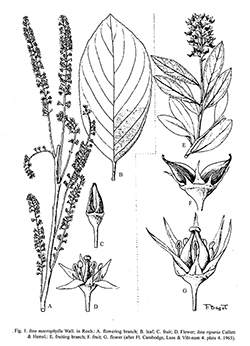e-Flora of Thailand
Volume 9 > Part 1 > Year 2005 > Page 37 > Iteaceae > Itea
1. Itea macrophylla Wall.wfo-0001234069
in Roxb., Fl. Ind. 2: 419. 1824; DC., Prodr. 4: 6. 1830; Hook.f. & Thomson, J. Linn. Soc., Bot. 2: 77. 1857; C.B.Clarke in Hook.f., Fl. Brit. Ind. 2: 408. 1878; Gagnep. in Lecomte, Fl. Indo-Chine 2: 686. 1920; Ridl., Fl. Malay Penins. I: 687. 1922; Backer & Bakh.f., Fl. Java 1: 507. 1964; O. Lecompte in Fl. Camb., Laos & Viêt-nam 4: 35, pl. 4, fig. 1–4. 1965; P.H.Hô, Câyco Viêtnam 1, 2: 1019, pl. 2882. 1991; S.Y.Jin & Ohba, Fl. China 8: 425. 2001.— Kurrimia ? macrophylla (Wall.) Wall., Cat.: 7200. 1832. Fig. 1 A(D).
Accepted Name : This is currently accepted.
Synonyms & Citations :
Description : Tree, to 10 m high, with drooping branches; bark thin, scaly, dark brown. Leaves: stipules soon caducous; petiole 16–27 mm long, pubescent; blade ovate to elliptic, 15–27 by 8–17 cm, chartaceous, base obtuse to rarely acute, apex acuminate, only slightly lighter below, with a slight pubescence on and along larger veins below, subglabrous above, venation distinct above and below, side veins in 9–12 pairs, tertiary veins percurrent, smallest veinlets reticulate, visible above. Inflorescences axillary, erect, 1–4 per node, 11–21 by ca 1.5 cm, the axis and pedicels with short and dense, erect hairs to ca 0.3 mm long; bracts ca 1.5 mm long, soon caducous and rarely seen, bracteoles not seen. Flowers: pedicel 2–3 mm long; hypanthium ca 1.5 mm long (in fruit to 3 mm), calyx lobes 0.5–1 mm long; petals whitish, distinctly larger than sepals, 2–2.5 by ca 1 mm, erect in bud but soon reflexed; stamens with filaments 1.5–2 mm long; anthers to ca 0.7 mm long; ovary glabrous. Fruits greenish; pedicel 3–4 mm long; sepals persistent, petals sometimes present; capsule ca 3 by 1.5–2 mm excluding styles, glabrous.
Thailand : NORTHERN: Chiang Mai (Doi Inthanon, Doi Suthep – type of Itea puberula: Kerr 2000, holotype -K, isotypes -AAU BM E P).
Distribution : India (type), Bangladesh, Indochina, SW China (Yunnan, Hainan), Malaysia Java, Borneo, the Philippines.
Ecology : In primary evergreen forests, hill evergreen forests, over granite, 1,000–1,500 m alt. Flowering: August, September, November; fruiting: December–February, April.
Notes: The Thai plants, originally described as Itea puberula, are more distinctly pubescent than the typical Himalayan plants including the type of I. macrophylla. Considering the variablity over the whole distribution, the Thai plants do not deserve specific rank.

